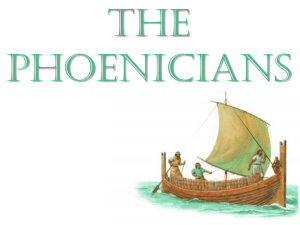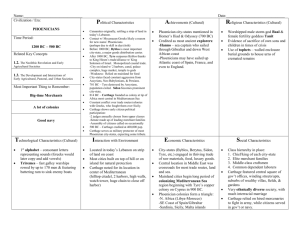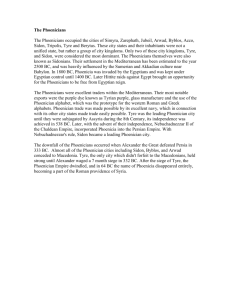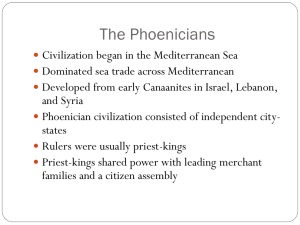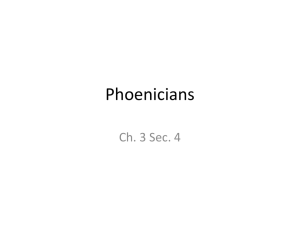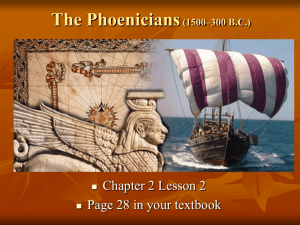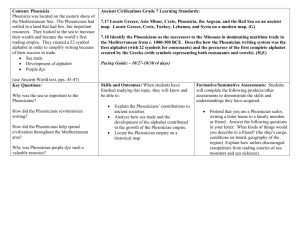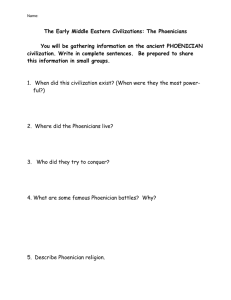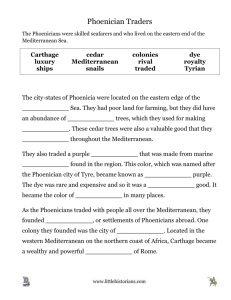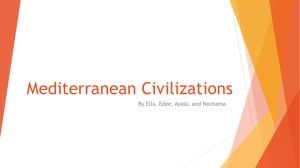20130111153695
advertisement
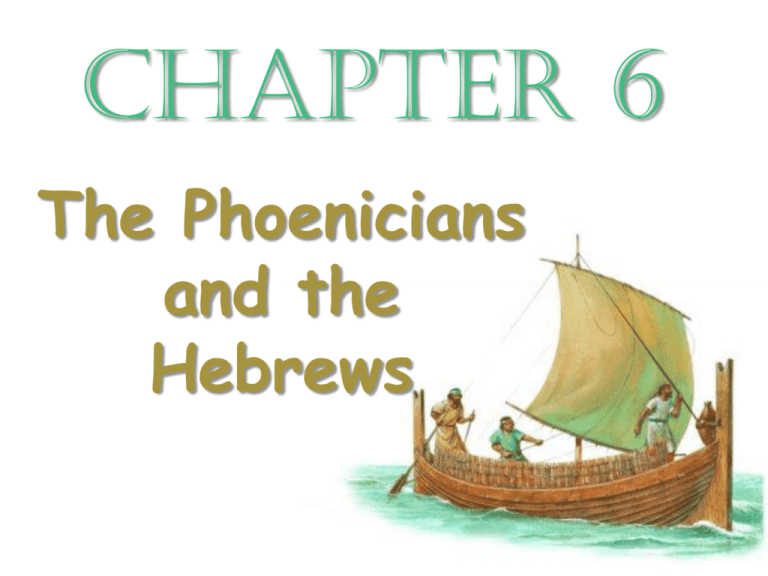
Chapter 6 The Phoenicians and the Hebrews When and Where? • 1200 B.C. – 510 B.C. • Present day Lebanon and Israel Ancient days: was a bridge between Egypt and Mesopotamia Section 1 The Phoenicians The Phoenicians • Lived in northern Canaan (Cannanites) • We learned about them from Bible, other ancient peoples, and ruins of cities and ships The Phoenicians • Semitic-speaking people (Semitic – languages of Southwest Asia and North Africa) • Settled in small city-states in present day Lebanon (Northern Canaan) • Canaanites: herders to traders • Why? Growth of Trade • Could not grow enough food to feed their people • Few natural resources so they turned to the sea • One resource was abundant… Trade • Mountains produced cedar forests • Built ships of cedar • Began coastal trading • By 900 B.C. they dominated Mediterranean sea trade • Some sailors were artisans who carried work with them on ships Sailors • Sailors and explorers plotted course using sun and stars – no maps or modern technology • Sailed beyond Gibraltar • Some believe they sailed around west coast of Africa • Some believe they sailed across Atlantic Phoenician City-States • Independent citystates • Never united • Why? Mountains separated them! Zahle Jounieh Major City-States • Tyre • Byblos • Beirut • Sidon Byblos Byblos Byblos Byblos Byblos Beirut Beirut Beirut Beirut Beirut Sidon Sidon Sidon Tyre Tyre Tyre Tyre City-States • Shared common language and religion but quarreled (trade profit) • Ruled by king who was also priest • Rich merchants forced kings to share power with councils of merchants • Councils soon told kings what to do City-States • Surrounded by walls • Crowded • Buildings close together; made of stone or brick (roof gardens) • Port – outside walls; center of activity Phoenicians became… • Carpenters and cabinet makers (wood) • Metal workers (learned from Egypt & Mesopotamia) Cities became… • Cloth dying centers • Soon gained a monopoly on purple dye and cloth • Purple dye • ”Phoenician” = “of purple merchants” Legend • God named Melqart was walking along seashore with Tyrus and a dog • dog picked up shellfish called Murex • dog’s mouth turned purple • Tyrus refused marriage unless Melqart gave her a gown of purple Gods and Goddesses • Polytheistic • Nature: worshipped on hills and under trees at first • Later built temples Temples • Entrance hall • Main hall • Holy of holies (most sacred chamber) Afterlife • Believed in afterlife • At first – buried in urn (ornamental vases) • Later – embalmed (influenced by Egyptians) Phoenicians learned to make agreements (business): • Treaties: agreements between states or countries • Made treaties agreeing to ship others’ goods in exchange for guaranteed Phoenician independence Phoenician Colonies • With new wealth (from trade) they began to build permanent settlements • Est. trading colonies throughout the Med. • Colony – region controlled by a distant country • Carthage – famous Pho. Colony in North Africa Carthage • Phoenician sailors and traders built post and colonies (permanent settlements) along northern Africa • Carthage – founded in 814; present day Tunisia Legend of Carthage • City was found by Phoenician princess (Dido) • Dido ruled Tyre • Her brother killed her husband • She fled to North Africa and built Carthage Contributions Phoenician coins were minted by individual city states Tyre The Alphabet • Ideas spread through trade • Most important gift – idea of alphabet • Did not invent alphabet but passed on to Mediterranean areas • Each of the 22 Phoeniciacn alphabet symbols represented a different sound • The Greeks eventually adopted this alphabet • Page 105 in textbook shows alphabet Travel and trade encouraged cultural diffusion
